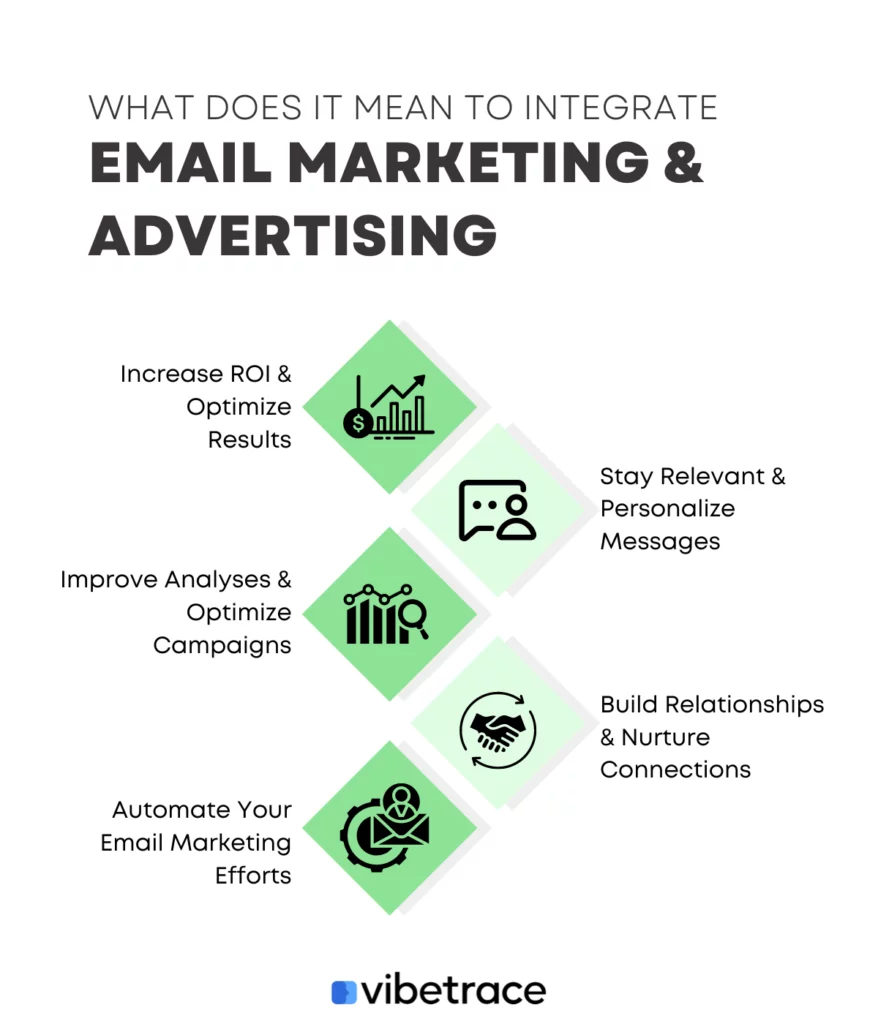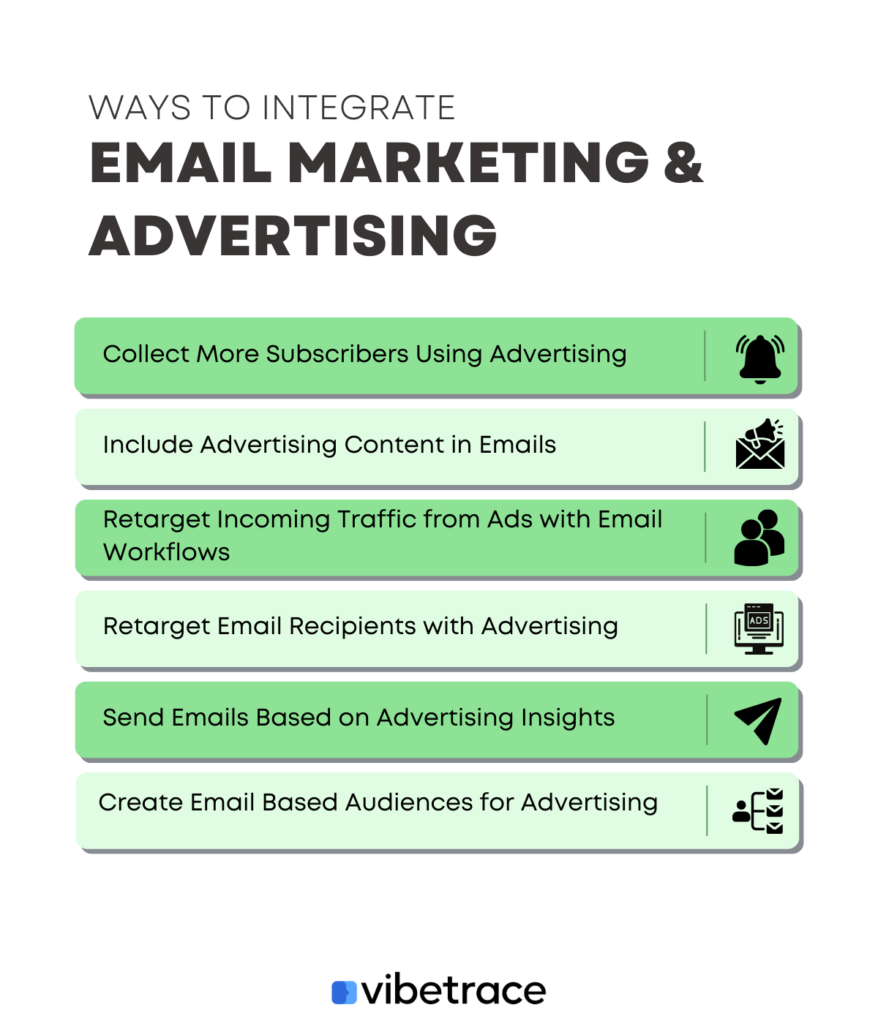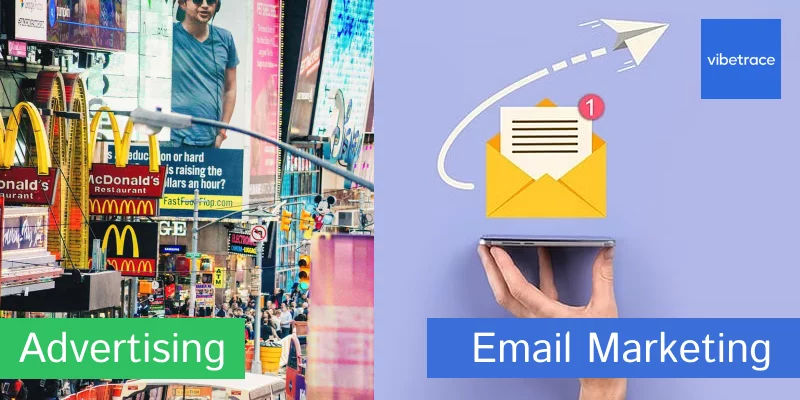Connect the dots on your customer’s journey and never leave your results to chance. That’s exactly what you can achieve when you integrate email marketing and advertising.
Using the tools at your disposal for email marketing and advertising, you can achieve better, more predictable results. Years ago, the two channels existed in separate bubbles, but today, reality’s different.
Today, you can’t afford to keep your email marketing separate from the rest of your marketing efforts.
Tools like VibeTrace make the integration of email marketing easier so that you can focus on optimizing your results. But how does it all work, and how does it close the circle? That’s what we’re here to find out!
What is Email Marketing?
Email marketing is one of the most powerful tools you can use today. It’s permission-based, and that’s made it a key element for e-commerce success. That’s an irreplaceable channel that can help you:
- boost brand awareness;
- generate and nurture leads;
- build strong relationships with your customers;
- keeping customers engaged and your business – at the top of their mind.
With the evolution of digital marketing and the development of resources, tools, and platforms at your disposal, you can make email marketing more effective than ever.
Tools allow you to segment your audience and send highly personalized messages and offers. You can create tailor-made emails that convert better than any paid ad. But you shouldn’t pit them against each other.
On the contrary, use them in tandem and accelerate your store’s growth. Here’s how advertising fits into the bigger picture and helps create a loop for your marketing efforts and target audience.
What is Advertising?
Advertising has been around long before email marketing. Once upon a time, it occurred only offline, but with the rise of the digital age, it’s become one of the best instruments to reach your audience whenever and wherever they are.
While offline ads on billboards, flyers, storefronts, and so on still play a role in marketing strategies, they don’t apply to all businesses.
If you’re an online store owner, you can benefit much more from digital advertising.
You’d still be paying for space to promote your products, but in a more accessible way that can reach more people than traditional ads. You can leverage placements on social media platforms and solutions like Google Display Ads.
And when you integrate email marketing with advertising, use the generated insights and optimize your campaigns, the results will follow. And if that’s not enough, here are the overall benefits for your business from integrating them.
What Does It Mean to Integrate Email Marketing and Advertising?
As I mentioned, you can’t afford to separate the different marketing channels and treat them independently. Using them in sync is the only way to improve your results and accelerate your business growth. Here’s the overall effect you can achieve when you integrate email marketing and advertising as part of your overall marketing strategy:

1. Increase ROI & Optimize Results
Email marketing is known for being among the most effective channels for generating conversions. You can:
- learn more about your target audience and your customers’ behavior through emails;
- track their engagement;
- determine the efficiency of your messages;
- create better segmentation.
The fact that email marketing requires the user’s permission also means they will be more interested in and receptive to your offers – willingly accepting promotional content. Effective campaigns, naturally, lead to better ROI.
When you combine that with the insights you gain from advertising, you can create even more personalized and relevant messages for your subscribers.
Alternatively, you can use the insights from your email campaigns to find your subscribers wherever they are online and serve them the content that will convert them. And this leads me to the next undeniable benefit.
2. Stay Relevant & Personalize Messages
When you integrate email marketing and advertising, you make sure you will be able to personalize your messages through both channels.
Use the tons of data you can acquire from communication channels, like overall shopping habits, browsing behavior, engagement and interests, purchasing intent, and where your potential customers are.
You can serve emails and ads at every step of your customer’s journey, carrying the best possible message for the stage they’re on.
And their actions will help you determine what messages work and what don’t. That is actionable information that allows you to improve your campaigns, as you’ll see next.
3. Improve Analyses & Optimize Campaigns
Analyzing results and customers’ patterns is key to achieving better results. If you decide to integrate email marketing and advertising within your strategy, you’ll have multiple data streams you can cross-reference and analyze.
The insights you gain from both channels can work together to inform you about your visitors’ and customers’ behavior.
Your end goal is to deliver the most relevant and powerful messages.
You’ll be able to test different messages and copy, as well as the type of offers you send – personalized recommendations, upsells and cross-sells, time-sensitive discounts, exclusive offers, and so on, to find out what works best with both existing and new customers.
And once you capture them – nurture them!
4. Build Relationships & Nurture Connections
Integrated email marketing gives you the best solution to turn one-time visitors/buyers into loyal customers. With using emails, you don’t have to compete with algorithms or every advertiser in your niche.
If you haven’t started collecting emails, don’t wait any longer! Emails are the most personalized way in which you can communicate directly with your audience and nurture the relationships you have with them.
All that sounds very time-consuming, but it doesn’t have to be.
Modern marketing automation platforms have made sure you can spend more time on strategic activities that will help your business grow by automating mundane and repetitive tasks.
You need to set up your email marketing automation workflows right now!
5. Automate Your Email Marketing Efforts
VibeTrace is one of the best marketing automation platforms you can use today.
It helps you automate the overall emailing process – from welcoming your new subscriber to converting them again and again through personalized emails based on their segment, point in their journey, and general behavior. It helps you eliminate guesswork.
You can automate sending product recommendations, upsell and cross-sell offers, birthday discounts, special offers, and so much more.
VibeTrace provides a built-in rich Customer Data Platform that helps you gain all the insights you need to leverage to provide a better experience and boost your results.
If you’re still wondering how to achieve all that and actually integrate email marketing and advertising to generate better results, keep reading!
Ways to Integrate Email Marketing and Advertising
Advertising specialists today are all about numbers and experimenting with audiences.
That can often lead to tunnel vision, which stops them from seeing the bigger picture. And the truth is that while these are two separate channels, you need to integrate email marketing and advertising if you want to be present at every point of your customer’s journey.
Here are several ways in which you can achieve this integration and thus – boost your results and accelerate your growth:

1. Collect More Subscribers Using Advertising
Today, organic reach is a mission impossible. You compete with thousands of SEO-optimized websites and just as many pages and business profiles operating in your niche on social media.
That’s where paid ads come into play. They help you expand your reach and drive traffic. The best part – targeted ads help you place yourself in front of the right audience.
Paid ads are under your complete control.
That means you can link to dedicated landing pages you can treat as lead magnets.
In the context of e-commerce, such pages can be special discounts, product showcases, loyalty program pages, and even landing pages built for giveaways. And on these pages, you can capture leads, thus growing your email list.
A powerful platform like VibeTrace allows you to create dedicated landing pages in just a few clicks. The platform’s landing page builder helps you:
- Boost sales with special offers;
- Capture qualified leads with customizable opt-in forms;
- Track user behavior and customer data;
- Manage subscriptions to find a willing audience;
- Launch surveys for improved segmentation and more.
With A/B testing, you can launch multiple landing pages and test the best messages, creatives, and copy that work with the audience of your paid ads.
By taking this step to integrate email marketing and advertising, you can both grow your lists and segment them better, as well as optimize your ads based on the campaign insights – information you can use for successful remarketing and retargeting.
And the best part is that there’s no limit to the ideas you can come up with to create attractive lead magnets.
2. Include Advertising Content in Emails
Featuring ads in emails sounds counterintuitive if you’re already producing a steady stream of emails. The decisive moment here is to create the ad as an addition to your email and not make it the bulk of the content. Otherwise, the email might seem too aggressive and put off subscribers, boosting unsubscribe rates instead of sales.
What’s the point of email ads, though? You can achieve two primary goals:
- Highlight the most current promotions running on your website;
- Generate additional ROI from existing subscribers.
You can approach the matter of including advertising content in your emails in several ways.
These include solutions like display ads – similar to those customers come across while surfing the web – embedded ads with text, static images, or video communicating a particular promotion.
Another option are the so-called native ads that integrate seamlessly into the email content and design.
How to decide whether it will be worth placing advertising content in your emails?
They work better for larger subscriber lists – 10,000 or more subscribers, with audiences identified as loyal and engaged (they’re more likely to respond positively to ads).
Make sure your message is clear and your niche – well-defined. And last but not least, including ads makes sense if you have high CTRs and open rates.
3. Retarget Incoming Traffic from Ads with Email Workflows
Retargeting is one of the most beneficial instruments at your disposal. You can apply it to both your email marketing and advertising using the data generated from both channels.
When you capture leads through ads, you can easily segment those and create dedicated email marketing workflows for such visitors/customers.
Let’s say you create a lead magnet landing page offering a 10% discount for leaving an email address.
The visitor submits an email and leaves without purchasing. Depending on the data at your disposal, you can automatically segment them as first-time visitors and into a “Welcoming paid subscribers” email workflow that immediately sends out an email featuring a discount.
In contrast, organic visitors that subscribe for the first time might receive a different welcoming email and enter a completely different workflow – all because they came from a different channel.
Depending on their behavior after receiving that first email, you can seek to re-engage and retarget them.
Retargeting traffic from ads with email marketing has one primary goal – moving the customer-to-be down the funnel. As was mentioned earlier, paid ads boost your reach and often help you find potential customers that have not landed on your site yet.
Your goal is to capture them through your ads and then leverage that contact for retargeting to move them from TOFU to BOFU – from top-of-the-funnel to bottom-of-the-funnel, where they convert into paying customers.
4. Retarget Email Recipients with Advertising
Retargeting your existing subscribers with ads is another great opportunity provided by modern advertising platforms.
Both Facebook and Google Ads allow you to use your own sources to target customers. You can create custom audiences based on your segments.
While retargeting through ads is usually used to reach anonymous visitors and make them return to the website, you can leverage those tools to reactivate existing subscribers.
Do you like this article?
Join our CX for Retail dedicated newsletter!

Stay connected to what’s really important to optimize your digital revenues.
By clicking the button, you accept our Terms & Conditions. Also you will need to confirm your email address.
We receive dozens of emails every day and often fail or refuse to pay attention to all of them.
And even though you can manage this through email workflows, it’s worth trying to reach your subscribers on the web when their engagement with your brand and emails has dropped.
Using ads to retarget subscribers is another example of how you can integrate email marketing and advertising. That can help you with:
- Staying in the mind of customers;
- Reaching them wherever and whenever they are;
- Providing them with personalized and exclusive discounts;
- Getting them back to your website;
- Making them re-engage with your brand.
What makes this beneficial is that you’re targeting already paying customers that are (or have been) engaged with your brand. You can eliminate a huge chunk of the guesswork that comes into developing quality display ads.
You can achieve all this with the help of a rich data platform and advertising solutions you might be using already. To answer how, we’ll cover leveraging insights and custom audiences in greater detail below.
5. Send Emails Based on Advertising Insights
Successful email marketing is equal parts analyzing insights and creating quality email content. You can’t rely on random campaigns, as flashy as they might be.
You must base content and workflows on actionable insights and data about your target audience if you want your efforts to be rewarded with higher ROIs and more loyal, paying customers.
Insights coming from your advertising (specifically retargeting ads for existing subscribers) provide you with actionable information you can use to optimize your email marketing campaigns.
Simply because you’ll learn more about your audience – how they browse the web, their interests, and where you can find them. That helps you improve your email content and creatives and generate better results.
Through ads on social media, you can gain information about their lifestyle and interests, expand your data based on demographics, and leverage information like hobbies and careers.
Knowing what your audience likes or dislikes about your business and the promotions you run allows you to create even better email campaigns with much more relevant content.
And that goes both ways when you integrate email marketing and advertising, as you’ll see below:
6. Create Email Based Audiences for Advertising
Cross-channel communication must be coherent to appeal to your target audience.
You can’t target customers with one message over email and an entirely different one through ads and expect steady and growing results.
We all switch between devices constantly and are bombarded by promotional materials, slogans, and attractive offers. As a marketer and an e-commerce store owner, you want to maintain a coherent message across channels.
That’s where targeting your existing subscribers with advertising can be invaluable. When your customer closes your email, let them see you online, reminding them of the superb offer you sent them. You can achieve that in two ways:
- The aforementioned custom audiences – upload your lists to advertising platforms. You can create custom audiences for specific segments you can choose based on various factors – most engaged customers, most paying customers, regular visitors and conversions, loyal customers, and so on. Advertising platforms can match your lists with the users that have used the email you have and reach them.
- Lookalike audiences for better reach – if the result of creating a custom audience is too narrow, you can create the so-called lookalike audiences. Those will be new people, similar to your specific segments and most favorite customers.
It’s up to you how narrow or broad the audience you create from your email lists will be. Why is it worth it?
Facebook found out1 that people who’ve seen both emails and ads from marketers are 22% more likely to make purchases. Another massive boost from the integration is the 77% increase in email marketing campaign reach because of coordinated News Feed ads.
But to get on the way to quality and effective integration between these two channels, you’ll have to get technical.
In the next section, I’ll open the doors to these aspects to ease you into the process of integrating email marketing and advertising.
Technical aspects of integration
Perhaps the most defining factor in successfully integrating email marketing and advertising is identifying attribution. And the only surefire way to do that is by using the so-called UTM parameters. That’s where things become a bit more technical.
Use UTM Parameters
UTM (Urchin Tracking Module) parameters are a must in both email marketing and advertising. They get attached at the end of an URL. That helps you gain insights into the source of a lead or a conversion. There’s a total of 5 UTM parameters you can add to the tail of a URL, with 3 of them mandatory and the other 2 – optional:
- utm_source – indicates the source of the traffic, the communication channel that’s led to a visit, a lead, or conversion, e.g. Facebook or an automated newsletter.
- utm_medium – indicates the type of traffic that has been generated, in other words – how you’ve captured a visitor, e.g. email or paid ads, in our case.
- utm_campaign – through this, you can track the results of the specific campaign that’s generated traffic – let’s say, a special promotion or a new style guide.
That sums up the three mandatory UTM parameters. The other two are:
- utm_content – to help you identify which link exactly has been clicked. Let’s say you’re tracking an email with three links – a banner, a button CTA, and an in-line CTA, all of which point to the same URL. Through this UTM, determine which link has the best CTR and optimize future campaigns with that knowledge in mind.
- utm_term – most common in paid ads to help you determine which keywords helped get the visitor to your site.
UTM parameters are invaluable for improved segmentation, as you’ll see in the next section, and that’s why it’s crucial to use them for traffic attribution.
Track Visitors with VibeTrace
Even if you’re not tracking visitors yet, you must be aware they have countless interactions with your store and brand every day. Event tracking is an essential ingredient for your efforts for several reasons:
- Identify key touchpoints in customer journeys;
- Develop better automation workflows based on touchpoints;
- Improve messages at different touchpoints and different stages of your customer’s journey;
- Improve customer satisfaction and retention;
- Boost the overall results of your business and achieve accelerated growth.
By using UTM parameters when you integrate email marketing and advertising and combining them with the VibeTrace platform, you can record Visitors events and their interactions with your brand. That helps you in two primary ways:
- Identify where users are coming from;
- Improve segmentation based on traffic sources.
Improved segmentation is crucial for creating effective custom audiences and retargeting campaigns through email and ads. Identifying visits from referrals like advertising and emails helps you narrow your segmentation and enhance the interactions your automation workflows and overall marketing efforts create at touchpoints.
The platform seamlessly integrates with Google Analytics, allowing you to use the tracking and attribution capabilities of GA in full. And now that you know all that, the only question remaining is whether you’re ready to integrate email marketing and advertising to achieve better ROI and higher CTRs for boosted conversions.
Ready to Integrate Your Email Marketing and Advertising?
Digital marketing has made tracking users and delighting them easier than ever. Don’t treat different communication channels as separate instruments despite their fundamental differences.
Target audiences and current and potential customers unite apparently incompatible channels, like ads and emails.
If you decide to integrate email marketing and advertising, you’re on your way to enhanced results and improved customer experience. Now, you can do it with the help of a powerful marketing automation platform like VibeTrace.
Leave the guesswork out and leverage all that invaluable tracking data in the best way possible – book a VibeTrace demo today!1Marketing to the Connected Consumer: Coordinating Email and Facebook ads, https://www.facebook.com/business/news/insights/marketing-to-the-connected-consumer-coordinating-email-and-facebook-ads

